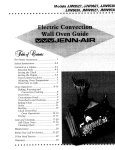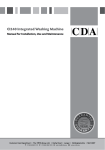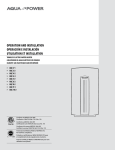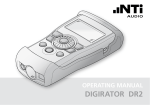Download Audio Technica 2000 Series Specifications
Transcript
DR-2000 Series Professional UHF Wireless Systems DR-2505 UniPak™ Transmitter System DR-2606 Handheld Dynamic Microphone System Installation and Operation Professional UHF Wireless Systems Installation and Operation This device complies with part 15 of the FCC Rules. Operation is subject to the condition that this device does not cause harmful interference. This device complies with INDUSTRY CANADA R.S.S. 210, en conformité avec IC: RSS-210/CNR210. Operation is subject to the following conditions: 1) This device may not cause harmful interference and 2) this device must accept any interference received, including interference which may cause undesired operation. Changes or modifications not expressly approved by Audio-Technica could void your authority to operate this equipment. CAUTION! Electrical shock can result from removal of the receiver cover. Refer servicing to qualified service personnel. No user-serviceable parts inside. Do not expose to rain or moisture. The circuits inside the receiver and transmitter have been precisely adjusted for optimum performance and compliance with federal regulations. Do not attempt to open the receiver or transmitter. To do so will void the warranty, and may cause improper operation. Notice to individuals with implanted cardiac pacemakers or AICD devices: Any source of RF (radio frequency) energy may interfere with normal functioning of the implanted device. All wireless microphones have low-power transmitters (less than 0.05 watts output) which are unlikely to cause difficulty, especially if they are at least a few inches away. However, since a “bodypack” mic transmitter typically is placed against the body, we suggest attaching it at the belt, rather than in a shirt pocket where it may be immediately adjacent to the medical device. Note also that any medical-device disruption will cease when the RF transmitting source is turned off. Please contact your physician or medical-device provider if you have any questions, or experience any problems with the use of this or any other RF equipment. Introduction Thank you for choosing an Audio-Technica professional wireless system. You have joined thousands of other satisfied customers who have chosen our products because of their quality, performance and reliability. This Audio-Technica wireless microphone system is the successful result of years of design and manufacturing experience. Each DR-2000 Series wireless system provides a choice of eight PLL synthesized UHF frequencies in the 542-561 MHz band (TV channels 26-29). All DR-2000 Series wireless systems offer both manual and automatic frequency scanning. Each wireless system includes a receiver and either a body-pack or handheld transmitter. 2 The DR-R22 receiver features Diversity Reception. Logic circuitry monitors reception, selecting the superior signal from two antennas, providing better sound quality and reducing the possibility of interference and dropouts. Soft-touch controls provide convenient access to selection of operating frequency and automatic scanning, while an LED display indicates selected channel and scanning operation. The versatile DR-T250 UniPak™ body-pack transmitter has both low- and high-impedance inputs plus a bias connection, for use with dynamic and electret condenser microphones, as well as Hi-Z instrument pickups. The UniPak transmitter also offers separate trim controls for guitar and microphone, plus switchable high/low RF power. The DR-T260 handheld dynamic microphone/transmitter features a rugged dynamic unidirectional element designed for professional live-sound venues. Transmitters in the DR-2000 Series use two 1.5V AA batteries for economical operation and wide availability. Both transmitters also feature a multi-color Power/Mute/Battery indicator. DR-2000 Series receivers feature a sophisticated Tone Lock™ tone squelch system that opens the receiver's audio output only when a DR-2000 Series transmitter is detected, reducing the possibility of interference. As a result, DR-2000 Series transmitters and receivers must be used together and should not be used with components from other Audio-Technica wireless systems, or with those of other manufacturers. Please note that in multiple-system applications there must be a transmitter-receiver combination set to a separate channel (frequency) for each input desired (only one transmitter for each receiver). Because the wireless frequencies are within UHF TV frequency bands, only certain channels (operating frequencies) may be useable in a particular geographic area. The eight channels (operating frequencies) that are used in the DR-2000 Series have been selected for multi-channel compatibility. Subject to frequency availability in a particular geographic area, any of these eight channels may be used together. The operating frequencies that correspond to each of the eight channels are listed on page 7. Receiver Installation Location For best operation the receiver should be at least 3 ft. (1 m) above the ground and at least 3 ft. away from a wall or metal surface to minimize reflections. The transmitter should be at least 3 ft. from the receiver, as shown in Figure A. Keep antennas away from noise sources such as digital equipment, motors, automobiles and neon lights, as well as away from large metal objects. Figure A Antennas Extend the permanently attached UHF antennas. The antennas are normally positioned in the shape of a “V” (both 45° from vertical) for best reception. Diversity Indicators on the receiver front panel will indicate which antenna is active. Power Connections Connect the DC plug on the included AC power adapter to the DC power input on the back of the receiver. Secure the cord over the cord hook on the back of the receiver, to keep the plug from being detached by an accidental tug on the cord. Then plug the adapter into a standard 120 Volt 60 Hz AC power outlet. Output Connections There are two audio outputs on the back panel: balanced (-16.5 dBV) and unbalanced (-13.5 dBV). Use shielded audio cable for the connection between the receiver and the mixer. If the input of the mixer is a 1/4" jack, connect a cable from the 1/4" unbalanced audio output on the back of the receiver housing to the mixer. If the input of the mixer is an XLR-type input, connect a cable from the balanced XLR-type audio output on the back panel to the mixer. Receiver Controls and Functions Figure B1-Antenna Position 1 1. Figure B2-Front Panel Controls and Functions 1 ANTENNAS: Position the antennas as shown in Figure B1. Fully extend both antennas by pulling on the endcaps. 2. AF PEAK INDICATOR: Indicates when maximum transmitter modulation without distortion has been reached. Not affected by position of Volume control (Fig. C). 3. LED WINDOW: LED Display indicates channel setting and scanning operation. 4. DIVERSITY INDICATORS: Indicates which antenna (A or B) has better reception and is in operation. 5. SELECT BUTTON (for manual channel selection): Press the Select button repeatedly until desired channel is reached. Press and hold the Set/Scan button to manually set the receiver to indicated channel. Channel number will stop flashing. (A brief touch of the Set/Scan button will revert to previously set channel). If the Set button is not pressed within 10 seconds to confirm the selection, the system will revert to its original channel. 2 3 4 5 6 6. SET/SCAN BUTTON: The Set/Scan button can be used in two ways: 1) in conjunction with the Select button to permit manual selection of an operating channel in Manual Set Mode (see “Select button” description above); and 2) Automatic Scan/Set Mode, to initiate the automatic channel scan and selection, as follows: Automatic Scan/Set Mode: Press and hold the Set/Scan button for about two seconds. The current channel will flash three times quickly; then the system will begin to scan for the next open channel. When it finds an open channel, it will flash the open channel three times and then set the channel. (If an open channel is not found, the automatic scan will return to the original channel and flash 5 times.) 3 Receiver Controls and Functions (Continued) Figure C-Rear Panel Controls and Functions 10. BALANCED AUDIO OUTPUT JACK: XLRM-type connector. A standard 2-conductor shielded cable can be used to connect the receiver output to a balanced microphone-level input on a mixer or integrated amplifier. 8 10 9 11. CORD HOOK: Loop the cord around the cord hook to keep the DC plug from pulling out accidentally. 11 12 8. UNBALANCED AUDIO OUTPUT JACK: 1/4" phone jack. Can be connected to an unbalanced aux-level input of a mixer, guitar amp or tape recorder. 12. POWER INPUT JACK: Connect the DC plug from the included in-line AC adapter. 9. AF LEVEL (VOLUME) CONTROL: Adjusts audio output level of both AF Output jacks; maximum output is fully clockwise. Transmitter Setup, Controls and Functions Battery Selection Two 1.5V AA alkaline batteries are recommended. UniPak™ Transmitter Battery Installation 1. Open the transmitter door by first pulling the catch down and then sliding the door upward (Fig. D). 2. Observe correct polarity as marked and carefully insert two fresh 1.5V AA alkaline batteries (Fig. D). 3. Slide the door closed, making certain it clicks securely in place. Figure D-UniPak Transmitter Handheld Transmitter Battery Installation 4. Unscrew the lower body cover, slide it downward, and remove it to expose the battery compartment. 5. Observe correct polarity as marked inside the battery compartment and carefully insert two fresh 1.5V AA alkaline batteries. Insert the first battery and slide it toward the spring contact. Then insert the second battery into the space remaining. Make certain the batteries are fully seated in the battery compartment. (Fig. E) 6. Slide the lower body cover back on and screw the housing together. Do not overtighten. Note: Remove batteries from the handheld transmitter starting at the bottom end, where finger indents in the battery housing are provided for easy grip. Figure E-Handheld Transmitter Battery Compartment Transmitter Door (Open Positon) RF Power Select Switch Screwdriver Transmitter Door Transmitter Door Catch Channel Selector Switch Screwdriver Battery Compartment 4 Battery Compartment Transmitter Setup, Controls And Functions Power/Mute/Battery Indicator After the battery is installed, press and hold the power button until the battery indicator LED turns green (Fig. F & G). (It will turn red first; keep holding until it turns green). If the battery indicator LED does not light up when the power button is pressed, the batteries are installed incorrectly or they are dead. The LED will flash to indicate low-battery condition. Figure F-UniPak Transmitter Top View Power/Mute/ Battery Indicator Input Connector Figure G-Handheld Transmitter Bottom View Power/Mute/ Battery Indicator UniPak Transmitter Input Connection Connect an audio input device (microphone or guitar cable) to the audio input connector on the top of the transmitter. A number of Audio-Technica professional microphones and cables are available separately, pre-terminated with a UniPak input connector (see “Optional System Accessories” on page 7.) UniPak Transmitter Antenna The UniPak transmitter includes a permanently-attached flexible antenna. For best results, allow the antenna to hang freely and full length from the transmitter. If the received signal is marginal, experiment with different transmitter positions on your body or instrument; or try repositioning the receiver. Do not attempt to remove, replace or change the length of the transmitting antenna. Antenna Power Switch Mute Function With the transmitter on, a slight touch of the Power/Mute button will toggle between muted and unmuted operation. Red LED indicates muted operation. Green LED indicates unmuted operation. Power Switch System Operation Plug in the receiver. Receiver On… The LED display will light up. If either A or B diversity indicators lights up at this point (without transmitter on) there may be interference in the area. If this occurs, change the operating channel. How to Make Operating Channel Changes Operating channel changes (frequency changes) may be made in two ways: manually and automatically. To change channel manually Press the Select button repeatedly until desired channel is reached. Press and hold the Set/Scan button to manually set the receiver to indicated channel. Channel number will stop flashing. (A brief touch of the Set/Scan button will revert to previously set channel). If the Set button is not pressed within 10 seconds to confirm the selection, the system will revert to its original channel. To change channel automatically Press and hold the Set/Scan button for about two seconds. The current channel will flash three times quickly; then the system will begin to scan for the next open channel. When it finds an open channel, it will flash the open channel three times and then set the channel. (If an open channel is not found, the automatic scan will return to the original channel and flash 5 times.) Transmitter On… Before turning on the transmitter, use the provided screwdriver to set the transmitter channel selector switches (Fig. D on page 4 and Fig. H on page 6) to the same number that is displayed on the receiver. Select channels 1-8 (channels 9 and 0 are for service use). The transmitter may be either on or off when changing channels (frequencies). When changing channels with the transmitter on and unmuted, the LED will turn red as the adjustment is being made; it will turn green when the channel is set. (When changing channels with the transmitter on and muted, the LED will remain red during and after channel adjustment, as long as the transmitter is muted; when the transmitter is unmuted, the LED will turn green.) The transmitters have a soft-touch Power Switch. When the transmitter is “on,” the transmitter produces both RF and audio. When the transmitter is switched on and in normal operation, the receiver's diversity indicators will display which antenna is active. Setting Levels Correct adjustment of transmitter audio input, receiver audio output, and mixer/amplifier input and output levels is important for optimum system performance. ATW-T260 Handheld Transmitter The DR-T260 Series handheld transmitter trim (volume) control (Fig. H on page 6) has factory pre-set audio input levels. Factory setting is full clockwise, maximum gain. Set the receiver's AF Level control to its full clockwise position (maximum). (Fig. C on page 4). While speaking/singing into the microphone at typically loud levels, check the AF peak indicator on the receiver. If the AF peak indicator is easily illuminated and distortion is heard through the system, it may be necessary to adjust the transmitter audio input level. To adjust the transmitter audio input level, unscrew the lower body cover and slide it downwards, exposing the screwdriver and trim control (Fig. H on page 6). Remove the screwdriver and gently turn the trim control counterclockwise until the AF peak indicator is illuminated only on audio peaks. Return the screwdriver to its clip and close and secure the lower body. No further transmitter gain adjustments should be needed, as long as the acoustic input does not change significantly. 5 System Operation Setting Levels (Continued) DR-T260 Handheld Transmitter CAUTION! The small trimmer controls are delicate; use only the supplied screwdriver. Do not force the trimmers beyond their normal 180° range of rotation. Return the screwdriver to its storage clip when not in use. Figure H-Handheld Transmitter Interior View Trim Control (Volume) Channel Selector Switch Screwdriver (Continued) 6. For MIC: While again speaking/singing into the microphone at typically loud levels, adjust the mixer's input trim control so the highest sound pressure level going into the microphone causes no input overload in the mixer, and yet permits the mixer's channel and output level controls to operate in their “normal” range (not set too high or too low). For INSTRUMENT: While again playing the instrument at typically loud levels, adjust the receiver's AF Level control so the highest signal level causes no input overload in the instrument amplifier and yet permits the amplifier's input level controls to operate in their “normal” range (not set too high or too low). Note: If the mixer cannot be adjusted to operate in its normal range without distortion, adjust the receiver's AF Level Control (turn counterclockwise) until the mixer/amplifier is no longer overloaded. Note: RF power may be set to high or low via the RF power select switch on the side of the UniPak transmitter. (Fig. I.) While the high setting normally provides maximum operating range, the low setting will help extend battery life. The low setting may also be preferred in multi-channel systems, or when operating very close to the receiver, to reduce the possibility of interference or overload. Figure I-UniPak Transmitter Side Views DR-T250 UniPak™ Transmitter Trim controls in the UniPak transmitter (Fig. I) will enable you to use microphones or instruments with different output levels. 1. For MIC: Set MIC (microphone trim) control fully clockwise (maximum) and INST (instrument trim) control fully counter clockwise (low). For INSTRUMENT: Set INST (instrument trim) control fully clockwise (maximum) and MIC (microphone trim) control fully counterclockwise (low). 2. Set the receiver's AF Level control to its full clockwise position (maximum). (Fig. C on page 4). 3. Plug the mic or instrument into the transmitter and power up the system. Instrument Trim Control (Volume) Microphone Trim Control (Volume) RF Power Select Switch Transmitter Door Catch 4. For MIC: Make an initial adjustment of the mixer's level controls that will allow audio through the system. For INSTRUMENT: Make an initial adjustment of the instrument amplifier input level control that will allow audio through the system. 5. For MIC: While speaking/singing into the microphone at typically loud levels, check the AF peak indicator on the receiver. If AF peak indicator is easily illuminated and distortion is heard through the system, it may be necessary to adjust the transmitter audio input level. To adjust the transmitter audio input level, gently turn the microphone trim control counterclockwise until the AF peak indicator is illuminated only on audio peaks. 6 For INSTRUMENT: While playing the instrument at typically loud levels, check the AF peak indicator on the receiver. If AF peak indicator is easily illuminated and distortion is heard through the system, it may be necessary to adjust the transmitter audio input level. To adjust the transmitter audio input level, gently turn the instrument trim control counterclockwise until the AF peak indicator is illuminated only on audio peaks. RF Interference Please note that wireless frequencies are shared with other radio services. According to Federal Communications Commission regulations, “Wireless microphone operations are unprotected from interference from other licensed operations in the band. If any interference is received by any Government or non Government operation, the wireless microphone must cease operation...” If you need assistance with operation or frequency selection, please contact your dealer or Audio-Technica. Extensive wireless information also is available on the Audio-Technica Web site at www.audio-technica.com. DR-2000 Series UHF Operating Frequencies DR-2000 Series Frequency Channel Plan Channel Each transmitter/receiver system operates on a choice of eight switch-selected frequencies. Available frequencies are shown in the chart. All frequencies may be combined for up to 8 simultaneous operating channels. Frequency - MHz 1 2 3 4 5 6 7 8 542.125 545.750 551.500 552.000 557.875 559.375 560.500 561.250 TV Channel 26 27 28 29 Specifications† OVERALL SYSTEM UHF Operating Frequency Number of Channels Frequency Stability Modulation Mode Maximum Deviation Operating Range Operating Temperature Range Frequency Response RECEIVER Receiving System Image Rejection Signal-to-noise Ratio Total Harmonic Distortion Sensitivity Audio Output Unbalanced Balanced Output Connectors Unbalanced Balanced Power Supply Dimensions Net Weight Accessory Included 542.125 MHz to 561.250 MHz 8 ±0.005%, Phase Lock Loop Frequency control FM ±25 kHz 200' typical 40º F (4ºC) to 110º F (43º C) 100 Hz to 12 kHz Antenna Switching Diversity 55 dB minimum >80 dB at 10 kHz deviation (IEC weighted), maximum deviation 25 kHz ≤1% (10 kHz deviation @ 1 kHz) 25 dBµV (S/N 60 dB at 10 kHz deviation, IEC-weighted) 211 mV (-13.5 dBV) (1 kHz modulation, 10 kHz deviation) 150 mV (-16.5 dBV) (1 kHz modulation, 10 kHz deviation) /4" TS (“mono”) phone jack XLRM-type 100-240 VAC (50/60 Hz) to 12V DC 1A (center positive) switched mode, external power supply 7.48" (190.0 mm) W x 1.65" (42.0 mm) H x 5.12" (130.0 mm) D 12.9 oz (365 g) Power supply UNIPAK™ TRANSMITTER RF Power Output Spurious Emissions Dynamic Range Input Connections Batteries (not included) Current Consumption Battery Life Dimensions Net Weight (without batteries) HANDHELD TRANSMITTER RF Power Output Spurious Emissions Dynamic Range Microphone Element Batteries (not included) Current Consumption Battery Life Dimensions 1 Weight (without batteries) Accessory Included † High: 10 mW; Low: 5 mW Under Federal Regulations >100 dB, A-weighted High impedance, Low impedance, Bias Two 1.5V AA Alkaline High: 140 mA; Low: 130 mA, typical Approximately 8 hours (High); 10 hours (Low), depending on battery type and use pattern 2.56" (65.0 mm) W x 4.13" (105.0 mm) H x 0.73” (18.5 mm) D 2.8 oz (80 g) 10 mW Under Federal Regulations >100 dB, A-weighted Dynamic Unidirectional Two 1.5V AA Alkaline 120 mA, typical Approximately 12 hours depending on battery type and use pattern 9.65" (245.0 mm) long, 2.11" (53.5 mm) diameter 9.1 oz (257 g) AT8456a Quiet-Flex™ stand clamp In the interest of standards development, A.T.U.S. offers full details on its test methods to other industry professionals on request. Specifications are subject to change without notice. Optional System Accessories MICROPHONES DR-8HW Headworn hypercardioid dynamic microphone terminated for use with the UniPak transmitter. DR-LW Miniature cardioid condenser lavalier/clip-on microphone terminated for use with UniPak transmitter. DR-GCW Guitar output cable with 1/4" phone plug to locking connector for use between guitar and UniPack transmitter. 38" long. OTHER ACCESSORIES AT8114 Foam windscreen for handheld transmitter. AT8390 Premium instrument cable with 1/4" to 1/4" phone plugs. Available in a variety of lengths. AT8431 Stand clamp for handheld transmitter, 5/8"-27 treads. AT8456a ATW-VP10 Quiet-Flex™ microphone stand clamp for handheld transmitter, 5/8"-27 threads. Vinyl pouch with belt clip to hold UniPak transmitter. 7 Ten T ips to Obtain the Best Results 1. 1. 2. 1. 1. 2. 2. 3. 2. 3. 3. 4. 3. 4. 4. 5. 4. 5. 6. 5. 5. 6. 7. 6. 6. 7. 7. 7. 8. Best If the AF Level control of the receiver is set too high, it Use only fresh alkaline batteries. Do not use “general Ten T ips to Obtain the Results mayResults over-drive the input of the mixer or clip the output of purpose” (carbon-zinc) batteries. Ten T ips to Obtain the Best 8. Best If the AF Level controldistortion. of the receiver is set if too high, it Use only fresh alkaline batteries. Do not use “general the receiver, causing Conversely, the receiver Ten T ips to Obtain the Results may the input the mixer or the ratio output Position receiver sobatteries. that it hasDo the fewest possible purpose” (carbon-zinc) is Level set too 8. output If theover-drive AF control ofof the receiver is clip set too high, it of low, the overall signal-to-noise of Use onlythe fresh alkaline batteries. not use “general the receiver, causing distortion. Conversely, the receiver obstructions between and the normal of the over-drive the the mixer or the output 8. may If the AF Level control ofof the receiver is clip set if too high, the system may beinput reduced. Adjust the output level ofit of purpose” (carbon-zinc) Use only fresh alkalineitbatteries. batteries. Do not location use “general Position receiver sobatteries. that it has the fewest possible output is setso transmitter. Line-of-sight is best. too low, theofoverall signal-to-noise ratio of of the causing distortion. Conversely, ifthe the receiver mayreceiver, over-drive the input the mixer or clip level output receiver the highest sound pressure going purpose”the (carbon-zinc) obstructions betweensoit that and it the normal location of the Position the receiver has the fewest possible the receiver, system reduced. Adjust the output level of output setmay the causing distortion. Conversely, if the receiver into theismicrophone (or loudest instrument playing too be low, thethe overall signal-to-noise ratio of The transmitter and the receiver must set to the same transmitter. is best. obstructions between and the normal location of the Position the Line-of-sight receiver soit that it has the be fewest possible the so highest sound pressure level going output is setmay level) causes nothe input overload insignal-to-noise the mixer, andlevel yet the receiver system be reduced. Adjust the output of too low, the overall ratio of frequency. Set or change frequency transmitter. Line-of-sight istransmitter best. obstructions between it and the normal locationonly of the into the the microphone (or controls the sound loudest instrument playing permits mixer topressure operate in their the receiver so the highest level going system may belevel reduced. Adjust the output level of The transmitter and the receiver must be set to the same when its power is turnedisoff. transmitter. Line-of-sight best. level) causes nothe input overload in or the mixer, and yet “normal” range (not set toosound high too low). This into the microphone (or the loudest instrument playing the receiver so highest pressure level going frequency. Set or change transmitter The transmitter and the receiver mustfrequency be set to only the same permits the mixer level controls tothe operate inentire their provides the optimum signal-to-noise for the system. level) causes no input overload in mixer, and yet into the microphone (or the loudest instrument playing The transmitter and the receiver should be as close when its power is turned off. frequency. Set or change transmitter The transmitter and the receiver mustfrequency be set to only the same “normal” range (not set too high or too low). This permits the mixer level controls to operate in their level) causes no input overload in the mixer, and yet together conveniently butfrequency no less than when its as power turned possible, off. frequency. Set orischange transmitter onlysix 9. provides In the UniPak transmitter, thehigh “Mic” or inputsystem. the optimum signal-to-noise for“Inst” the “normal” range (not set too too low). This permits the mixer level controls tooroperate inentire their The the receiver should be as close feet transmitter (2its m.). when power and is turned off. control not inoptimum use should be high set toorminimum. provides the signal-to-noise for the entire system. “normal” range (not set too too low). This together as conveniently possible, but no less than six The transmitter and the receiver should be as close 9. provides In the UniPak transmitter, the “Mic” or inputsystem. the optimum signal-to-noise for“Inst” the entire Yellow thereceiver channel isbut setno to service position feet (2 LED m.). together as indicates conveniently possible, The transmitter and the should beless as close than six 10. In Turn transmitter off when nottoinminimum. use. Remove control not in use should be 9. thethe UniPak transmitter, theset “Mic” or “Inst” inputthe (0 or(2 9);m.). please select a valid operating channel (1-8).six together as conveniently possible, but no feet less than battery if the not totobe used for ainput period of 9. In the UniPak transmitter, the “Mic” or “Inst” control not in transmitter use should is be set minimum. Yellow LED indicates the channel is set to service position feet (2 m.). 10. time. Turn the transmitter off when not inminimum. use. Remove the Unplug the receiver from the AC outlet when the control not in use should be set to The antennas be kept from any (0 orreceiver 9);LED please selectthe ashould valid operating channel (1-8). Yellow indicates channel is setaway to service position battery ifistransmitter the transmitter is notnot to in beuse. usedRemove for a period system not in use. 10. Turn the off when the of metal. (0 or 9);LED please selectthe a valid operating (1-8). Yellow indicates channel is set channel to service position Unplug the receiver thein outlet theof battery iftransmitter the transmitter isfrom notnot to beAC used forwhen a period 10. time. Turn the off when use. Remove the The antennas be kept away from any (0 orreceiver 9); please select ashould valid operating channel (1-8). system is not in use. time. Unplug the receiver from the AC outlet when theof battery if the transmitter is not to be used for a period A receiver cannot receive signals fromaway two transmitters metal. The receiver antennas should be kept from any system is not in use. time. Unplug the receiver from the AC outlet when the at the same time. metal. The receiver antennas should be kept away from any A receiver cannot receive signals from two transmitters system is not in use. metal. at the same time. receive signals from two transmitters A receiver cannot at the same time. receive signals from two transmitters A receiver cannot at the same time. For future reference, please record your system information here (the serial numbers appear inside the battery compartment of each transmitter, and on the bottom of each receiver): For future reference, please record your system information here (the serial numbers appear inside the battery Receiver DR-R22 compartment of eachplease transmitter, onSN the bottom of eachhere receiver): For future reference, recordand your system information (the serial numbers appear inside the battery compartment of eachplease transmitter, onsystem the bottom of eachhere receiver): For future reference, recordand your information (the serial numbers appear inside the battery UniPak™ DR-T250 and onSN S/N Receiver Body-Pack DR-R22 compartment of each transmitter, the bottom of each receiver): Transmitter Receiver DR-R22 SN UniPak™ Body-Pack DR-R22 DR-T250 S/N Receiver SN Handheld Body-Pack Dynamic DR-T260 S/N Transmitter UniPak™ DR-T250 S/N Microphone TransmitterDR-T250 UniPak™ Transmitter Body-Pack S/N Handheld Dynamic DR-T260 S/N Transmitter Microphone TransmitterDR-T260 Handheld Dynamic S/N Microphone TransmitterDR-T260 Handheld Dynamic S/N Microphone Transmitter One-Year Limited Warranty Audio-Technica professional wireless systems purchased in the U.S.A. are warranted for one year from date of purchase by Audio-Technica U.S., Inc. One-Year Limited ( A.T.U.S.) to be free of defects in materials and workmanship. In event of suchWarranty defect, product will be repaired promptly without charge or, at our option, replacedprofessional with a new wireless product of equal orpurchased superior value delivered A.T.U.S. orfor anone Authorized Service Center, prepaid, together with the Audio-Technica systems in theifU.S.A. are to warranted year from date of purchase by Audio-Technica U.S.,sales Inc. One-Year Limited Warranty Prior approval from A.T.U.S. is required fordefect, return.product This warranty due to normal wear, slip or other proof ( A.T.U.S.) to be freeofofpurchase defects date. in materials and workmanship. In event of such will beexcludes repaired defects promptly without charge or, abuse, at our One-Year Limited Warranty Audio-Technica professional wireless systems purchased in the U.S.A. are warranted for one year from date of purchase by Audio-Technica U.S., Inc. shippingreplaced damage, or failure use product inor accordance withifthe instructions. Thisor warranty is voidService in the event of unauthorized repair or modificaoption, with a new to product of equal superior value delivered to A.T.U.S. an Authorized Center, prepaid, together with the sales (Audio-Technica A.T.U.S.) to be free of defects in andpurchased workmanship. In eventare of warranted such defect, will bedate repaired promptly charge or, at Inc. our professional wireless systems the U.S.A. for product one from of purchase bywithout Audio-Technica U.S., tion, removal orof defacing of date. thematerials product labeling. purchase Prior approval fromin A.T .U.S. is required for return. Thisyear warranty excludes defects due to normal wear, abuse, slip ororother proof option, replaced with adefects new product of equaland or superior value ifIndelivered A.T.U.S. or anproduct Authorized Service Center, prepaid, together with or, theatsales (shipping A.T.U.S.) to be free in materials workmanship. oftosuch defect, will be repaired promptly without charge our damage, oroffailure to use product in accordance with theevent instructions. This warrantyU.S., is void in 1221 the event of unauthorized repair or modificaFor return approval and shipping information, contact the Service Dept., Audio-Technica Inc., Commerce Drive, Stow, Ohio 44224. date. of Prior approval fromvalue A.T.U.S. is required return. warranty excludes defects due together to normalwith wear, slip or other proof of purchase option, with a new product equal or superior if delivered to A.for T.U.S. or an This Authorized Service Center, prepaid, theabuse, sales tion, or replaced removal or defacing of the product labeling. the extent precluded by applicable state law, A.T .U.S. will have no liability for any consequential, incidental, or special damages; any Except to shipping damage, or failure to use product in accordance with the instructions. This warranty is void in the event of unauthorized repair or modificaslip or other proof of purchase date. Prior approval from A.T.U.S. is required for return. This warranty excludes defects due to normal wear, abuse, For return and shipping information, contact the Service Dept., Audio-Technica U.S., Inc., Commerce Drive, Stow, Ohio 44224. warranty ofapproval merchantability or for particular purpose when thiswarranty warranty tion, or removal oror defacing of use thefitness product labeling. shipping damage, failure to product in accordance with theexpires instructions. This is expires. void in 1221 the event of unauthorized repair or modificathe extent precluded by applicable stateyou law,may A.Tthe .U.S. will have nowhich liability forfrom anyU.S., consequential, incidental, or special any Except tion,return or to removal or defacing of the product This warranty gives you legal rights,labeling. and have other rights vary state to state. For approval andspecific shipping information, contact Service Dept., Audio-Technica Inc., 1221 Commerce Drive, Stow, damages; Ohio 44224. warranty ofapproval merchantability or fitness for particular purpose expires when this warranty expires. For return and shipping information, Dept., Inc., 1221 Commerce Drive, Stow, damages; Ohio 44224. extent precluded by applicable statecontact law, A.Tthe .U.S.Service will have no Audio-Technica liability for anyU.S., consequential, incidental, or special any Except to the This warranty gives you specific legal rights, may have will other rights which vary to state. incidental, or special damages; any warranty ofU.S.A., merchantability or fitness for and particular purpose expires when this warranty expires. the extent precluded by applicable stateyou law, A.T .U.S. have no liability forfrom any state consequential, Except tothe Outside please contact your local dealer for warranty details. warranty of merchantability orlegal fitness for and particular purpose expires when this warranty expires. This warranty gives you specific rights, you may have other rights which vary from state to state. Outside the U.S.A., contact yourrights, local and dealer warranty details. This warranty givesplease you specific legal youformay have other rights which vary from state to state. Outside the U.S.A., please contact your local dealer for warranty details. Consumer Alert Outside the U.S.A., please contact your local dealer for warranty details. Most users do not need a license to operate this wireless microphone system. Nevertheless, operating this microphone system without a license is subject to certain restrictions: the system may not cause harmful interference; it must operate at a low power level (not in excess of 50 milliwatts); and it has no protection from interference received from any other device. Purchasers should also be aware that the FCC is currently evaluating use of wireless microphone systems, and these rules are subject to change. For more information, call the FCC at 1-888- CALL-FCC (TTY: 1-888-TELL-FCC) or visit the FCC’s wireless microphone website at www.fcc.gov/cgb/wirelessmicrophones Audio-Technica U.S., Inc., 1221 Commerce Drive, Stow, Ohio 44224 330/686-2600 www.audio-technica.com P51869 ©2006 Audio-Technica U.S., Inc. Printed in U.S.A. Audio-Technica U.S., Inc., 1221 Commerce Drive, Stow, Ohio 44224 330/686-2600 www.audio-technica.com Audio-Technica U.S., Inc., 1221 Commerce P51869 ©2006 Drive, Audio-Technica Stow, Ohio U.S., Inc. 44224 Printed in 330/686-2600 U.S.A. www.audio-technica.com Audio-Technica U.S., Inc., 1221 Commerce Drive, Stow, Ohio 44224 330/686-2600 www.audio-technica.com P51869 ©2006 Audio-Technica U.S., Inc. Printed in U.S.A. P51869 ©2006 Audio-Technica U.S., Inc. Printed in U.S.A.

















